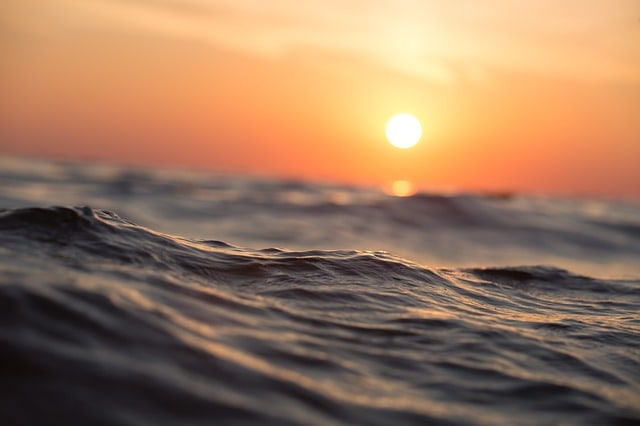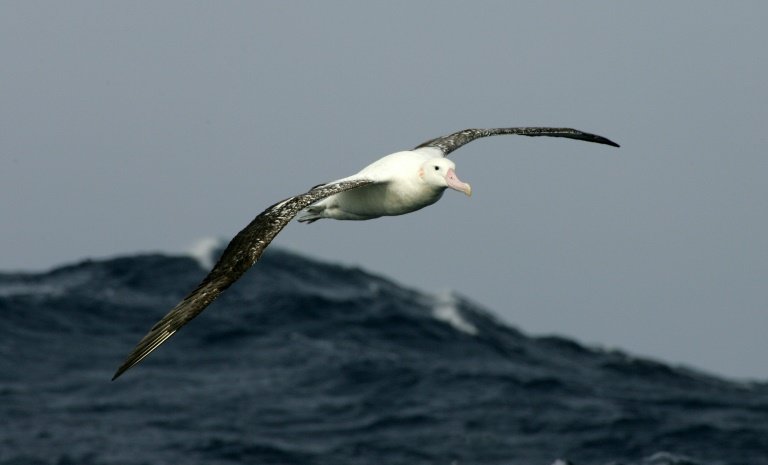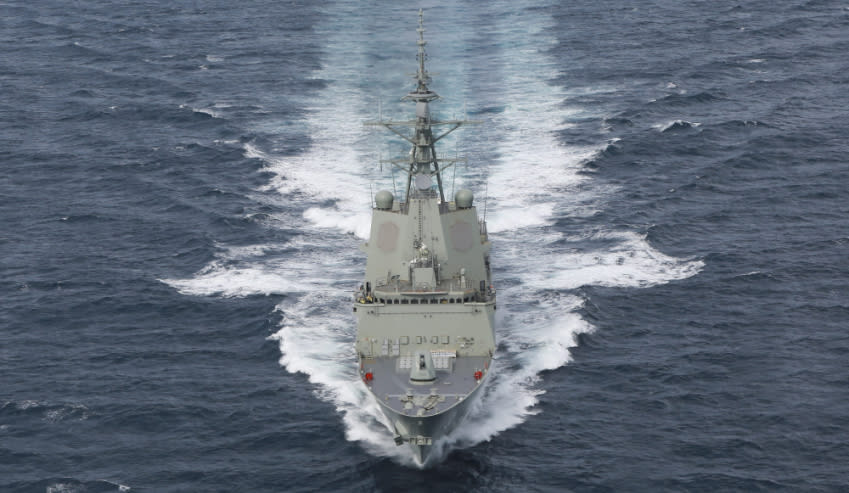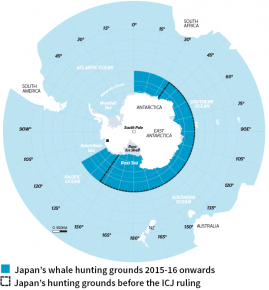I don’t disagree with the general principle and a purpose built ship such as Nuyina would always be best, but the RAN has been sending warships well south of 50 south, not frequently admittedly, since the late 1940s. It’s not very comfortable but you can do it. I wouldn’t choose an Arafura for the job, though.
Royal Australian Navy Discussions and Updates
- Thread starter icelord
- Start date
- Status
- Not open for further replies.
buffy9
Well-Known Member
I looked into it a bit.Why 48 South specifically? Just enough to get around South/Stewart Island? Or is it more about a marked change in conditions at that latitude?
Asking out of interest.
Regards,
Massive
There is an article by EarthEclipse (calling itself a paper) that summarizes the Southern Ocean. The most pertinent to operating in the Southern Ocean is "...The area of the ocean that ranges the latitude 40 south traveling to the Antarctic circle is said to have the strongest average winds found anywhere on Earth." It also notes later in the article of complex current systems, but I'm not a sailor so I don't know how that affects ships. What is clear is that there is very limited and distributed support infrastructure, with ports in Australia and New Zealand being the only major ones.

Southern Ocean: Climate, Islands, Depth, Location, Currents | Earth Eclipse
Southern Ocean can influence the global climate as it connects to the three major oceans: Indian, Atlantic and Pacific Oceans. It stores the huge amount of heat, carbon dioxide, and nutrients and helps to drive the currents of the Ocean all around the world.
 www.eartheclipse.com
www.eartheclipse.com
There is also the "The International Antarctic Weather Forecasting Handbook." I haven't read through a great deal of it, but it is a decent reference despite it's age (2004). I found this quote interesting:
"As the cold air from the south moves over the warmer, oceanic surface to the north strong baroclinic instabilities and convection occur, which together with the high cyclonic vorticity result in the formation of numerous mesoscale and synoptic scale cyclonic systems around the edge of the Antarctic domain." I have a friend who went through the Drake Passage between Argentina and Antarctica a few years ago. It's about as far away from the AAT as you can get in the Southern Ocean but for reference, he said it was some of the worst waters he has ever gone through.
Nothing on 48 degrees South specifically, however.
On a side note I'd argue there is not a current or near future need for OPV in the Southern Ocean, so long as the treaty remains current and relatively understood.
An ocean going vessel like the Nuyina is certainly more suitable for operating in the Southern Ocean. It is better suited to more extreme latitudes and with greater self-sufficiency than anything an OPV can provide. Whilst it can't conduct security operations, the size and capacity of the vessel is certainly a clear message to any foreign competitors with the benefit of actually being able to support scientific activity in the Antarctic. This is combined with recent demonstrations of C-17 and C-130 capability of Antarctic support (however limited). The OPV fleet is going to be of more use in North Australia, the South Pacific and SE Asia - as evidenced by defence interests in mine warfare, unmanned systems and constabulary roles, all three of which are far more prevalent in the North rather than in the South.
For the time being, so long as the treaty is still in effect, it is better to show influence in the AAT via major soft power (airlift, Nuyina, the AAD, etc) as opposed to minor hard power (OPV patrols, etc). In terms of stopping illegal fishing, I'd argue that a soft power approach may be more effective here. Stopping whaling would require standing up to Japan politically, which I don't see happening anytime soon. With this happening the only way to stop protest ships is to crack down on them, which may come with some public backlash (the Sea Shepherds have at least notable support in Tasmania, at the very least). Toothfish poachers are a more conventional constabulory challenge but there have been some notable ideas floated about recently. There are substantial seabird populations across the South, for use by these ideas:

Albatrosses to spy out illegal fishing
Fishermen illegally trawling the Indian Ocean might soon find they have more to worry about than the proverbial albatross around their neck—real bad luck might now lurk in the form of one of the birds spying on them from the sky.
If it does come to be a major issue, then maritime patrol/surveillance and space based sensors could also be of use, with the OPV fleet (or more major fleet assets) or DFAT then being directed to intercept. Illegal fishermen do have to come above latitude 50 at some point, after all.
A two cents, again.
Last edited:
Totally OT here but if there’s one activist group that infuriates me it’s Sea Shepherd.For the time being, so long as the treaty is still in effect, it is better to show influence in the AAT via major soft power (airlift, Nuyina, the AAD, etc) as opposed to minor hard power (OPV patrols, etc). In terms of stopping illegal fishing, I'd argue that a soft power approach may be more effective here. Stopping whaling would require standing up to Japan politically, which I don't see happening anytime soon. With this happening the only way to stop protest ships is to crack down on them, which may come with some public backlash (the Sea Shepherds have at least notable support in Tasmania, at the very least).
They’re lucky someone hasn’t been killed because of their reckless disregard for every safety convention I’ve held sacred for my entire working life at sea.
They may have noble intent but that doesn’t excuse their continual vandalism.
Their skippers should be jailed and their ships confiscated.
They have little regard for SOLAS, for international treaties or anything apart from their zealotry.
The fact that they continue is testimony to the power wielded over gutless politicians, of every stripe in every jurisdiction, by environmental activism.
Rant over!
Redlands18
Well-Known Member
And if God forbid there was a collision and they had to abandon Ship, who will be carrying out the rescue deep in a large part of the Southern Ocean? The RAN and or the RNZNTotally OT here but if there’s one activist group that infuriates me it’s Sea Shepherd.
They’re lucky someone hasn’t been killed because of their reckless disregard for every safety convention I’ve held sacred for my entire working life at sea.
They may have noble intent but that doesn’t excuse their continual vandalism.
Their skippers should be jailed and their ships confiscated.
They have little regard for SOLAS, for international treaties or anything apart from their zealotry.
The fact that they continue is testimony to the power wielded over gutless politicians, of every stripe in every jurisdiction, by environmental activism.
Rant over!
It has already happened. Have a look at the Andy Gill collision (much as I am not a fan of Wiki as a reference). The Andy Gill was trying to tow a wire in front of the whale catcher to foul the prop and both sides misjudged.And if God forbid there was a collision and they had to abandon Ship, who will be carrying out the rescue deep in a large part of the Southern Ocean? The RAN and or the RNZN

MY Ady Gil - Wikipedia
 en.wikipedia.org
en.wikipedia.org

andy gill sea shepherd - Bing
Intelligent search from Bing makes it easier to quickly find what you’re looking for and rewards you.
Their efforts to place vessels between a tanker and the vessel trying to refuel were alos inconsistent with the COLREGS and posed a significant danger to the environment.
50s is pretty far south. I don't envisage any ship other than those resupplying bases to go that far normally.
But I am worried about Sea Shepard and the interaction with Japanese whalers. Things are very nasty, and SeaSheppard seems willing to sacrifice ships for that purpose.

In addition, Treaty dates and competitive actions from a multitude of countries indicate a general increase in activity around the south. Even in peaceful and happy times that means more rescues and more assistance.
But I am worried about Sea Shepard and the interaction with Japanese whalers. Things are very nasty, and SeaSheppard seems willing to sacrifice ships for that purpose.

Into the maelstrom
Sea Shepherd claims its brand-new high-speed boat can outrun Japanese whalers. Join the crew in this exclusive insight as they sail to Antarctica to face off against the hunters.
www.smh.com.au
In addition, Treaty dates and competitive actions from a multitude of countries indicate a general increase in activity around the south. Even in peaceful and happy times that means more rescues and more assistance.
Attachments
-
118.7 KB Views: 17
To be fair, Sea Shepherd have pulled out of the Southern Ocean recently and are operating else where. We should drop that OT subject. Certainly tourism is an activity that is taking off down south and not without problems. From a strategic and response sense this is an area where planning is required.50s is pretty far south. I don't envisage any ship other than those resupplying bases to go that far normally.
But I am worried about Sea Shepard and the interaction with Japanese whalers. Things are very nasty, and SeaSheppard seems willing to sacrifice ships for that purpose.

Into the maelstrom
Sea Shepherd claims its brand-new high-speed boat can outrun Japanese whalers. Join the crew in this exclusive insight as they sail to Antarctica to face off against the hunters.www.smh.com.au
In addition, Treaty dates and competitive actions from a multitude of countries indicate a general increase in activity around the south. Even in peaceful and happy times that means more rescues and more assistance.
Studied climatology at post grad level and Antarctica at undergrad level when at uni.I looked into it a bit.
There is an article by EarthEclipse (calling itself a paper) that summarizes the Southern Ocean. The most pertinent to operating in the Southern Ocean is "...The area of the ocean that ranges the latitude 40 south traveling to the Antarctic circle is said to have the strongest average winds found anywhere on Earth." It also notes later in the article of complex current systems, but I'm not a sailor so I don't know how that affects ships. What is clear is that there is very limited and distributed support infrastructure, with ports in Australia and New Zealand being the only major ones.

Southern Ocean: Climate, Islands, Depth, Location, Currents | Earth Eclipse
Southern Ocean can influence the global climate as it connects to the three major oceans: Indian, Atlantic and Pacific Oceans. It stores the huge amount of heat, carbon dioxide, and nutrients and helps to drive the currents of the Ocean all around the world.www.eartheclipse.com
There is also the "The International Antarctic Weather Forecasting Handbook." I haven't read through a great deal of it, but it is a decent reference despite it's age (2004). I found this quote interesting:
"As the cold air from the south moves over the warmer, oceanic surface to the north strong baroclinic instabilities and convection occur, which together with the high cyclonic vorticity result in the formation of numerous mesoscale and synoptic scale cyclonic systems around the edge of the Antarctic domain." I have a friend who went through the Drake Passage between Argentina and Antarctica a few years ago. It's about as far away from the AAT as you can get in the Southern Ocean but for reference, he said it was some of the worst waters he has ever gone through.
Nothing on 48 degrees South specifically, however.
On a side note I'd argue there is not a current or near future need for OPV in the Southern Ocean, so long as the treaty remains current and relatively understood.
An ocean going vessel like the Nuyina is certainly more suitable for operating in the Southern Ocean. It is better suited to more extreme latitudes and with greater self-sufficiency than anything an OPV can provide. Whilst it can't conduct security operations, the size and capacity of the vessel is certainly a clear message to any foreign competitors with the benefit of actually being able to support scientific activity in the Antarctic. This is combined with recent demonstrations of C-17 and C-130 capability of Antarctic support (however limited). The OPV fleet is going to be of more use in North Australia, the South Pacific and SE Asia - as evidenced by defence interests in mine warfare, unmanned systems and constabulary roles, all three of which are far more prevalent in the North rather than in the South.
For the time being, so long as the treaty is still in effect, it is better to show influence in the AAT via major soft power (airlift, Nuyina, the AAD, etc) as opposed to minor hard power (OPV patrols, etc). In terms of stopping illegal fishing, I'd argue that a soft power approach may be more effective here. Stopping whaling would require standing up to Japan politically, which I don't see happening anytime soon. With this happening the only way to stop protest ships is to crack down on them, which may come with some public backlash (the Sea Shepherds have at least notable support in Tasmania, at the very least). Toothfish poachers are a more conventional constabulory challenge but there have been some notable ideas floated about recently. There are substantial seabird populations across the South, for use by these ideas:

Albatrosses to spy out illegal fishing
Fishermen illegally trawling the Indian Ocean might soon find they have more to worry about than the proverbial albatross around their neck—real bad luck might now lurk in the form of one of the birds spying on them from the sky.phys.org
If it does come to be a major issue, then maritime patrol/surveillance and space based sensors could also be of use, with the OPV fleet (or more major fleet assets) or DFAT then being directed to intercept. Illegal fishermen do have to come above latitude 50 at some point, after all.
A two cents, again.
The Southern Ocean is only the place in the world where the wind can blow around the world without being impeded by land. In the case of the Southern Ocean the winds are westerly, due to the coriolis effect, meaning that there is no physical barrier impacting upon the wind velocity and an unlimited fetch for wind wave generation. This results in higher wind speeds and larger waves on average than elsewhere in the world. What is not available from the Southern Ocean is a large database because very little data has been collected. There was some research done by the DSIR with the RNZN in the 1960s and the NIWA wave buoy recovered by the RNZN late last year.
Exactly mate, and for those that know some of the basics, check out the latest MSLP (Mean Sea Level Pressure) for the southern ocean, if you follow the charts, and do so on a daily basis for weeks, it is a constant circle of low pressure systems that continuously rotate around the Antarctic.Studied climatology at post grad level and Antarctica at undergrad level when at uni.
The Southern Ocean is only the place in the world where the wind can blow around the world without being impeded by land. In the case of the Southern Ocean the winds are westerly, due to the coriolis effect, meaning that there is no physical barrier impacting upon the wind velocity and an unlimited fetch for wind wave generation. This results in higher wind speeds and larger waves on average than elsewhere in the world. What is not available from the Southern Ocean is a large database because very little data has been collected. There was some research done by the DSIR with the RNZN in the 1960s and the NIWA wave buoy recovered by the RNZN late last year.
One of the other things that has also not been mentioned, and others can comment with more knowledge, is the steel used for such ships, it is not just a case of ice strengthening, as in basic design, thicker steel etc, but the type of steel used, consistent exposure to the temps down there render normal steel very brittle, unable to cope with normal torsional stresses etc, so much to be taken into account. Regular exposure is very different to the occasional "visit" let alone getting right down south !
Cheers
On the steel, yes it's an issue choosing the steel for a ship being built to operate in high latitudes. Some steels are developed to operate in very low temperatures where others might start becoming brittle. However, generally the open ocean temperatures don't get much below -2 or 3 so it becomes a real concern when the employment of a ship may require it to remain either in the ice, or in a situation where the air temperature becomes very cold, for extended periods - ie ice breakers and the like. Certainly it's needed if you a designing for -30 and below although for practical risk mitigation purposes the point where you start using it is if you expect exposure to around -15. You have to consider it for other ships which may operate there, but it's not so critical.
The Hobart class was modified to include ," allow cold weather operation infrastrcutre to allow deployment in Australias southern waters" exactly how far south was never suggested

 www.defenceconnect.com.au
www.defenceconnect.com.au

A closer look at Navy’s new guided missile destroyers
The Hobart Class Guided Missile Destroyers will provide the Navy with one of the world's most capable multi-purpose warships, enhancing the air defence, surface, subsurface
You have to define what Australia's southern waters are and both @spoz & @Takao have done that being 50°S.The Hobart class was modified to include ," allow cold weather operation infrastrcutre to allow deployment in Australias southern waters" exactly how far south was never suggested

A closer look at Navy’s new guided missile destroyers
The Hobart Class Guided Missile Destroyers will provide the Navy with one of the world's most capable multi-purpose warships, enhancing the air defence, surface, subsurfacewww.defenceconnect.com.au
Thanks. Just too add, as a general rule there are five lows around the Antarctic continent at any given time. The other thing not many realise is the surface air temperature that results from the katabatic winds that blow offshore from the continent. They are cold air masses that flow from the polar plateau at the top of the Antarctic ice sheet that is the polar cap. It's about 4 km above mean sea level (AMSL) and the ice there is 4 km thick. It's also where the South Pole is situated.Exactly mate, and for those that know some of the basics, check out the latest MSLP (Mean Sea Level Pressure) for the southern ocean, if you follow the charts, and do so on a daily basis for weeks, it is a constant circle of low pressure systems that continuously rotate around the Antarctic.
One of the other things that has also not been mentioned, and others can comment with more knowledge, is the steel used for such ships, it is not just a case of ice strengthening, as in basic design, thicker steel etc, but the type of steel used, consistent exposure to the temps down there render normal steel very brittle, unable to cope with normal torsional stresses etc, so much to be taken into account. Regular exposure is very different to the occasional "visit" let alone getting right down south !
Cheers
I read their comments as to do with the Arafura class of ships operations ,the Hobarts may have an even further range of operations under AMIS
I am not sure what you are getting at....I read their comments as to do with the Arafura class of ships operations ,the Hobarts may have an even further range of operations under AMIS
AMIS is simply an information system. The paper you apended simply spells out the rights of coastal, port and flag states to act under UNCLOS, SUA and SOLAS (noting the latter is limited to ports and territorial waters). Thre is no difference in the scope of actions available to an OPV or a DDG as they are both warships for the purpose of the convention.
It does though set out the desire to identify ships within 1000 kilometres of the coast and at some point intercept ? such vessels of interestif that meant for instance a vessel adopting dangerous practices around whaling ships perhaps action could be taken away from normal coastal areas of responsibility
Can someone clarify which block SM-2ERs the Hobart's will be fitted with as it seems to me that 'block IV' would provide an unusual capability for TBM defence?
Or will they be fitted with SM-2MRs?
Even the Hunters with this block would provide a great advantage to any group or squadron they might find themselves a part of.
Or will they be fitted with SM-2MRs?
Even the Hunters with this block would provide a great advantage to any group or squadron they might find themselves a part of.
Fair enough .... but that is a system, why does it specifically expand the operations of the DDG. It may actually prompt the use of the ADV Ocean Protector (which is basic ice class) or the border force vessel Ocean Shield (which is also basic ice class). It would not necessarily hold that a DDG would be employed for such operations.It does though set out the desire to identify ships within 1000 kilometres of the coast and at some point intercept ? such vessels of interestif that meant for instance a vessel adopting dangerous practices around whaling ships perhaps action could be taken away from normal coastal areas of responsibility
One of the requirements in modifications from the F100 hundred class was the modification of existing stowage and increases in the number of stowage facilities for thermal protective suits and life raft containers

 www.defenceconnect.com.au
I have not seen this requirement for the Hunter class would this not indicate other potential roles
www.defenceconnect.com.au
I have not seen this requirement for the Hunter class would this not indicate other potential roles

A closer look at Navy’s new guided missile destroyers
The Hobart Class Guided Missile Destroyers will provide the Navy with one of the world's most capable multi-purpose warships, enhancing the air defence, surface, subsurface
- Status
- Not open for further replies.

